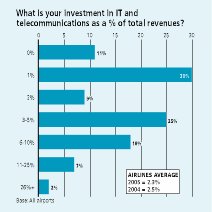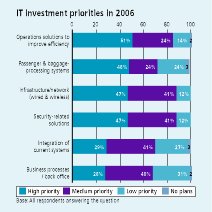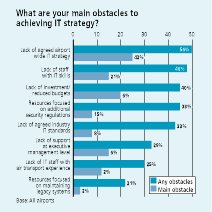Spending on IT is set to rise sharply according to the second Airport IT Trends Survey conducted by ACI, Airline Business and SITA
The strategic importance of IT to the operation and future development of airports is reinforced by results from the second Airport IT Trends Survey – delivered in partnership by Airline Business, SITA and Airports Council International (ACI). Results of the survey were presented at ACI’s World Annual General Assembly, held in Auckland, New Zealand, in November.
 Progress being made by airports as they adapt to new technologies warrants close attention from airlines, governments and key stakeholders alike. The desire to improve efficiency continues unabated as airports take their first steps towards an era of wireless, mobile technologies and common-use passenger services. Clearly, IT is beginning to make in-roads, with the potential to strengthen the bonds between airlines and airports.
Progress being made by airports as they adapt to new technologies warrants close attention from airlines, governments and key stakeholders alike. The desire to improve efficiency continues unabated as airports take their first steps towards an era of wireless, mobile technologies and common-use passenger services. Clearly, IT is beginning to make in-roads, with the potential to strengthen the bonds between airlines and airports.
The stature of the survey continues to rise as response levels this year swelled to 60 of the top 200 world airports, representing over a third of world passenger traffic and over half of world airport revenue.
As Airline Business and SITA have discovered with their Airline IT Survey, now in its seventh year, IT is storming up the boardroom agenda in the air transport industry. Around two-fifths of airports stated IT strategy decisions were made at a group rather than local level. This elevation of IT to the boardroom is confirmed by George Ellis, vice-president of information systems and telecommunications, Metropolitan Washington Airports Authority, who comments: “Last year a board committee was created especially for IT.”
While one airport admitted to a strategy lasting less then one year, the average duration increased to almost five years with nearly half looking much further ahead.
This reflects the longer planning horizons of airports and is greater than the three years reported by carriers. A lingering concern, in view of the executive level surveyed, is that almost one in 10 airports declared they had yet to develop an IT strategy.
For Martin Smith, head of group information services at the UK’s Manchester Airports Group, IT is a strategic board issue because “airports rely so critically on IT, investment must cover not only the usual equipment upgrades every three or four years, but also we must integrate the disparate islands of information and take advantage of the opportunities IT brings to cost-effectively improve services”.
Funds look likely to keep flooding into airport IT. This year average overall investment in IT and telecommunications as a proportion of total revenues increased from 4.1 to 4.6%, with over a quarter investing at much higher levels. This is much greater than the 2.3% invested in IT and telecommunications by the airlines. Additionally, nearly three-quarters of airports expect increased budgets next year, while the number suffering budget cuts has fallen through the floor, going from 22% last year to 11% this year.
 “The airport industry as a whole is investing around $2.5 billion a year on IT and telecommunications services, about a half a billion more than last year,” estimates Catherine Mayer, SITA’s, vice-president of airport services.
“The airport industry as a whole is investing around $2.5 billion a year on IT and telecommunications services, about a half a billion more than last year,” estimates Catherine Mayer, SITA’s, vice-president of airport services.
Unsurprisingly, budget concerns fall down the list of the main obstacles to overcome to second place. A lack of an agreed IT strategy jumps to top place, while others cite a lack of staff with IT skills and lack of support from executive management as key issues.
Airports appear more cautious than airlines about outsourcing, with over half preferring to keep network, desktop management and back-office applications all in-house. A continued, albeit slow, upwards trend in outsourcing passenger check-in and baggage systems is visible, beaten only by strong growth in self-service check-in outsourcing over the next two years
Security remains a vexing issue for IT executives worldwide. Over half of airports have already undertaken an IT security audit in the past year and another third aim to join them in the year ahead. “Airports are no different from any other organisation,” adds Ellis. “We’re facing increasing cyber threats and attacks and it’s an ongoing battle.” This may raise a sense of unease about the 14% of airports that declare they have “no plans” for a security audit. In times of heightened concerns, this may well be contributing to increased costs, but for Roland Krieg, senior vice-president of IT at Germany’s Fraport: “It is essential to be prepared; you have to define the level of security you want and invest accordingly.”
Common-use kiosks
The results indicate the beginnings of the proliferation of common-use kiosks, with almost half of airports expecting all or the majority of kiosks to be common-use. Underpinning this is the two-thirds of airports planning to deploy shared kiosks in the next two years, compared with just 2% for dedicated use. According to Peter Buecking, SITA president, this is because “airports can provide critical operations on a per-use basis more efficiently and cost-effectively than the airlines could,” adding that “smarter use of technology is a cost-effective way of dealing with the cocktail of demands this industry faces”.
Subtle changes in the ranking of the top IT investment priorities may help explain where the tide of funding is flowing. Improving operating efficiency has dropped down this list of priorities, with implementing fixed and wireless network infrastructure and security services taking the lion’s share of the pot.
 “Wi-Fi is available and affordable and it’s a public service and convenience we must have,” says Ellis, with plans under way at Washington’s airports to install Wi-Fi by the third-quarter of 2006. However, having installed Wi-Fi at Frankfurt five years ago, Roland Krieg cautions: “Expectations are sometimes over-hyped and finding operational and commercial users is key to delivering a return on investment.”
“Wi-Fi is available and affordable and it’s a public service and convenience we must have,” says Ellis, with plans under way at Washington’s airports to install Wi-Fi by the third-quarter of 2006. However, having installed Wi-Fi at Frankfurt five years ago, Roland Krieg cautions: “Expectations are sometimes over-hyped and finding operational and commercial users is key to delivering a return on investment.”
A new question this year shows airports principally running the facility, providing surveillance, administration, parking, maintenance and detection systems, while the airlines currently manage slightly more passenger services, such as check-in, baggage and point-of-sale systems.
Areas of influence will shift as airports move to take on a larger role as service provider, especially as their deployment of common-use kiosks expands. Strong growth also persists in self-service passenger boarding with the 13% of airports already using these systems rising to 61% in the next couple of years. According to Buecking this confirms that “airports are increasingly valuable partners to the airlines”. While Smith agrees, he advises: “The trick is building infrastructure and ways of working that help the airport to respond quickly to the challenging and varied needs of full-service through to low-cost airlines.”
Airports are leading dramatic advancements in passenger services as over half have already implemented web services for passengers, and this will grow to 90% by 2007. The “tipping point” – where a majority have the technology in place – is also approaching for managed airport campus networks with over three-quarters of airports aiming to have this installed by 2008.
At the other extreme, the small number installing voice-over IP, removing legacy check-in systems or providing integrated exchanges will continue to grow, but around a third of airports have no plans for these systems.
A few innovative airports have mobile passenger check-in and payment systems in place and this expands to around a third in the next few years. However, over half are opting to wait and see.
Trail blazers
This picture of a few blazing ahead and a cautious following group waiting to exploit technology innovations reflects the pattern found in the Airline IT Trends Survey. The two studies fix in place sections of what has become a very complicated aviation IT jigsaw.
Adoption rates for biometric check-in and boarding have slipped and the proportion of airports with plans over the next year or two has dropped. The most popular biometric applications for passengers and employees remain fingerprinting, facial recognition and iris scanning. By year-end, just a handful of airports will be using radio frequency identification tags for baggage and rollout across cargo lags at least a year behind. Sizeable numbers declare having no plans in either area at present.
This disparate picture of frustrated laggards and a leading bunch achieving their plans continues through to the verbatim comments. A selection of their remarks are shown here. A few cheerfully said there were “no failures” to report over the past year, but worrying numbers of airport IT directors are haunted by failing to deliver programmes or concerned about sluggish progress. The biggest successes last year were implementing infrastructure and wireless systems with the tightening of security systems and strategic planning all close contenders.
For the future, implementation and operational issues cloud the horizon as the single biggest challenge, closely followed by concerns over security, investment levels and worries of how to secure stakeholder co-operation. This last point is critical for Krieg, who says a “shift in mindset” is needed “moving the airport to being just one part of a network, whereas in the past it considered itself a spider in its own web.”
“Airports are waking up and embracing IT as they realise it’s the key to unlocking greater business and operational efficiencies,” says Mayer. “While every airport may be different, cost-effectively enabling airlines and other partners to ‘plug-in and play’ means open-standards and interoperability are crucial.”
Closer co-operation appears to offer greater opportunities to improve efficiency and deliver an efficient, streamlined experience. The benchmark data offered by the Airport and Airline IT Trends Surveys should help stimulate boardroom debate about the way ahead.
KARL MOORE/LONDON
Full results of Airport IT Trends Survey 2005 are available on CD,priced £250($450),For further details please email us at:airline.business@rbi.co.uk
Source: Airline Business
















